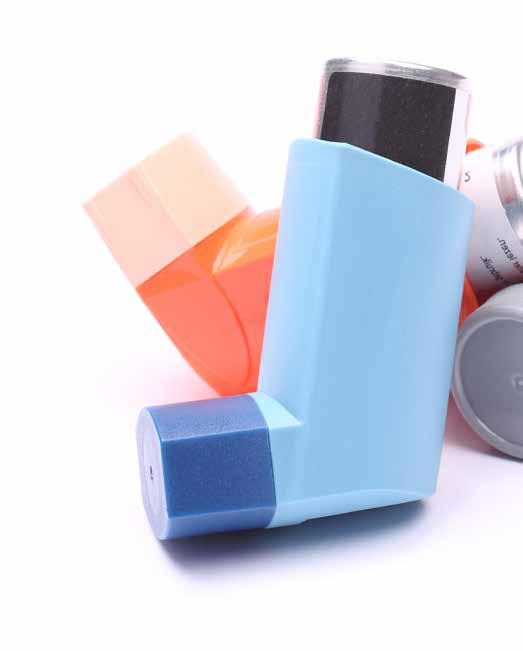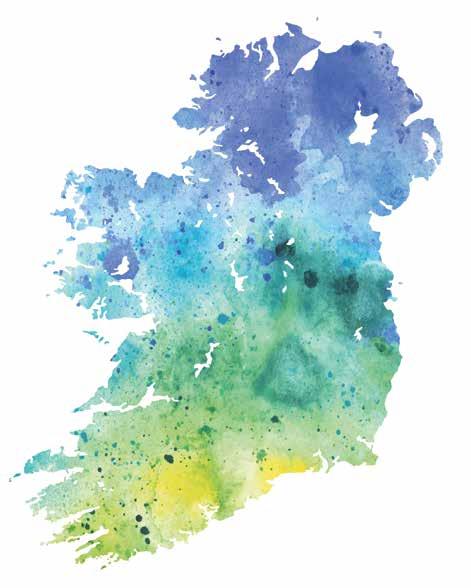
15 minute read
ATOPIC ECZEMA
ATOPIC ECZEMA – MORE THAN AN ITCHY RASH
Prof Anne-Marie Tobin, Consultant Dermatologist, Tallaght University Hospital, Clinical Associate Professor TCD; and Michelle Greenwood, Health Promotion Manager, Irish Skin Foundation, review the management of atopic eczema
Atopic eczema (AE), also known as atopic dermatitis, is a common, non-communicable, chronic, inflammatory skin condition characterised by intense itch and recurring eczematous lesions. AE is the most common inflammatory skin disorder in children and infants affecting approximately 20 per cent of children. However, for some, AE can persist or develop for the first time in adulthood with some reports suggesting up to 10 per cent of adults are affected. Clinical manifestations (appearance and location of eczematous lesions) of AE may vary with age, and three stages have been recognised, infancy, childhood, and adolescent/adult.
Presentation
Depending on severity, this inflammatory skin condition is recognisable by severe dryness caused by a dysfunctional epidermal barrier, intense itching, cutaneous inflammation, and vesicle formation. AE symptoms have a chronic, or relapsing disease course. As itch is a major symptom of AE, scratching only provides temporary relief, and leads to more itching and scratching, which is often referred to as the ‘itch-scratch-cycle’. The clinical appearance of AE may be modified by scratching, which in time may produce lichenification, broken skin surface resulting in excoriations, exudate, and secondary infection.
Pathophysiology and risk factors
The pathogenesis of this common inflammatory skin disease is complex, and comprises an interplay of genetics, immunologic and environmental triggers, that lead to a skin barrier disruption and abnormal immune system response.
A strong risk factor for AE is a positive family history and in excess of 30 susceptibility loci have been identified in genome-wide association studies. The strongest known genetic risk factor in AE is associated with null (loss-of-function) mutations in filaggrin gene (FLG), which encodes a key epidermal structural protein filaggrin, which is necessary for skin barrier function.
The epidermis acts as a barrier, preventing water loss, as well as entry of foreign substances such as irritants, microbes, and allergens. The epidermal barrier is made up of structural proteins including filaggrin (FLG). FLG deficiencies or mutations in the epidermis result in a weakened skin barrier, as it is less able to retain water, and the lipids that surround and support the cells break down more quickly.
The impaired skin barrier allows loss of moisture and irritants or allergens to pass through the skin more easily. This can ultimately prompt an inflammatory cascade. The immune response, which involves T-helper cell (Th) type 2 and other T-cell subsets, results in greater activity of interleukins, (IL)-4, IL-5, and IL-13 in both acute and chronic disease, which contribute to further changes which include activation of eosinophil and mast cells, B-cell IgE production and IL-31 secretion. This series of events is thought to lead to itch and further disruption to the skin barrier due to scratching.
Triggers of AE may include, allergen exposure such as house dust mite, whereas, non-allergic factors such as Staphylococcus aureus infection, abrasive garments, temperature changes, stress, and exposure to irritants such as detergents, harsh soaps and fragrances and habitual scratching can disrupt the skin barrier function.
Assessment and management of AE
Once a diagnosis of AE is established, treatment decisions are based on disease activity and impact of the disease on the patient’s quality-of-life. According to NICE guidelines, referral to dermatology specialist consultation is recommended if: a child’s eczema is uncontrolled or unresponsive, including recurring infections and/or a negative impact on quality of life and psychosocial wellbeing.

Assessment
The diagnosis of AE is made clinically and is based on clinical features, patient history, and exclusion of other dermatoses. Occasionally skin biopsy, blood tests and patch testing may be useful to rule out other skin conditions. The overall disease severity may be determined by using formal diagnostic criteria, of which several sets have been developed over time. One of the most acknowledged diagnostic criteria is the Hanifin and Rajka criteria.
A scientific refinement of the Hanifin and Rajka criteria was developed by the UK Working Party criteria. According to the UK Working Party diagnostic criteria, a diagnosis for AE requires patients must have a history of itchy skin plus a minimum of three of the following: ▸ Flexural involvement, involving skin creases such as behind the knees, bends of elbows, wrists, front of ankles, or neck ▸ History of generally dry skin in the last 12 months ▸ Visible flexural eczema ▸ Personal history of asthma or hay fever (or history of atopic disease in a first degree relative, if patient is under four years of age) ▸ Onset of signs and symptoms in the first two years of life. The European Task Force of Atopic Dermatitis developed the Scoring of Atopic Dermatitis (SCORAD), this index combines evaluation of extent, intensity of skin lesions and symptoms such as daytime itch and sleep loss. AE that scores above 50 is categorised as severe, while values below 25 are regarded as mild. Other disease severity scales used are the Eczema Area and Severity Score (EASI) which only assess the visible lesions extent and severity and not subjective symptoms, such as sleep disturbance and itch. In contrast the Patient-Orientated Eczema Measures (POEM) is a symptomsonly score measuring subjective symptoms and frequency from a patient’s perspective.
A really useful health-related quality of life measurement tool used in clinical practice is the Dermatology Life Quality Index (DLQI). This tool is not AE specific, however it helps clinicians to assess the impact of AE on the person’s life and assists the clinician to measure effectiveness of treatments. DLQI scores range from 0 (no impairment of quality-of-life) to 30 (maximum impairment). For children there is the Children’s Dermatology Life Quality Index (CDLQI) which also consists of 10 questions, with 4 possible replies, the scores also range from 0 to 30. The aim of the questionnaire is to measure how much the child’s skin condition affected them in the last week.
Management
AE is a life-long skin condition, so the main aim of treatment is to improve symptoms and achieve long-term control. Although there is no cure yet, typically a multistep treatment approach is considered, according to severity of the disease, patients age, and its extent and distribution.
The key principals in AE management are restoring the skin barrier with emollient therapy, baseline trigger avoidance, anti-inflammatory treatment with topical steroids or topical calcineurin inhibitors (non-steroidal immunomodulators). When topical treatments do not provide relief of symptoms, or in severe cases of AE, phototherapy maybe considered, and lastly, systemic immunosuppressants may be prescribed.
Topical treatments
Ongoing efficacious, practical application of over-the-counter emollients is the cornerstone of treatment for the condition (augmented by topical corticosteroids, or topical immunomodulatory treatments as needed), as dry skin is one of the predominant manifestations of AE. The purpose of emollients is to improve the skin barrier by restoring and maintaining skin hydration, therefore soothing the skin, and reducing pruritus. Emollients are also a crucial element of maintenance treatment and also in the prevention of flares. Adults require at least 500g/ per week and children at least 250g/per week. Pump dispensers are preferable,
in order to prevent contamination. The use of emollient wash products instead of ordinary soaps and bubble baths are also recommended. Bathing should be limited to short periods of time (eg, 5-10 minutes) with warm water, and when finished, followed by application of emollients.
In July 2020 the UK, Medicines and Healthcare Products Regulatory Agency (MHRA), in partnership with the National Fire Chiefs Council, launched a campaign to raise awareness around the potential fire risks of emollients (moisturisers) often used in the management of skin disease.
The British Association of Dermatologists (BAD) released a statement on their website in July 2020 on fire risk associated with emollient use. According to the BAD “emollients represent a safe treatment option, for most patients. That said, it is important that patients, carers, and healthcare professionals are aware of the potential fire risks associated with these products, and how to minimise them. It is important to stress that emollients are not flammable in themselves, nor when they are on the skin. The risk comes when emollient residue dries onto fabrics such as clothing or bedding and then comes into contact with a naked flame or lit cigarette causing them to catch fire.
To reduce the fire risk, patients using these products are advised to avoid naked flames completely, including smoking cigarettes and being near people who are smoking or using naked flames. It is also advisable to wash clothing and bed linen regularly.”
Wet-wrapping treatment is a technique used in people with moderate to severe eczema by using two layers of open-weave tubular bandage applied over emollients. The bottom layer is soaked in warm water, squeezed out and then put onto the skin over the emollient wet and then followed by the top layer which is dry. This treatment is reported to introduce moisture, soothe, and protect irritated skin from damage caused by scratching and is applied for short periods of time. Caution should be taken when wet wrapping using topical steroids, as absorption is increased. Occlusive medicated dressings or dry bandages should not be used in infected AE. Topical corticosteroids are recognised as first-line anti-inflammatory treatment in acute exacerbations, and selection of agent varies depending on po
tency, the location and severity of skin affected by AE, patient age and formulation. Topical corticosteroids are grouped into classes depending on their potency, ranging from mild, moderate, potent, and very potent. A fingertip unit (FTU) is a useful method for individuals to apply topical corticosteroid in safe quantities. An FTU refers to the amount of ointment or cream applied from the end of an adult index fingertip, to the distal crease (first joint) in the finger and is equivalent to approximately 0.5grams. The recommended FTU of topical corticosteroid will depend on the part of the body being treated and whether the patient is an adult or child. The Irish Skin Foundation has a useful guide describing the number of FTU’s required for different parts of the body in adults and children in the eczema booklet on https://irishskin.ie/eczema/.
Topical calcineurin inhibitors (TCI) are considered as a second-line option for short-term and intermittent treatment of AE. These non-steroidal, antiinflammatory agents do not cause skin atrophy, and are beneficial in treating sensitive skin areas such as the face and groin. Stinging on application is the most common side-effect, but this usually settles within a few days, also sun protection is advised, in patients treated with TCI.
Some patients and/or their carers may find application of topicals timeconsuming and inconvenient, fear of side effects and some treatments can be greasy in application. Due to these factors, patient adherence to topical therapy can be suboptimal. It is important that patients and/or their carers are educated with verbal and written instructions to support the safe and successful use of these treatments in the long-term and to set realistic expectations.
Phototherapy
Phototherapy is a form of artificial ultraviolet light treatment, comprised of either ultraviolet A (UVA) or ultraviolet B (UVB) wavelengths of light, delivered in hospital dermatology day care centres. Narrowband UVB is the most common type of phototherapy used to treat AE and is usually given three times a week. Another form of phototherapy that may be prescribed is PUVA. UVA must be combined with a light sensitising medication such as psoralen to be effective, which is commonly known as PUVA and this is given twice a week. Phototherapy may be given in combination with topical steroids and emollients to prevent flare-up.
Systemic treatment
Oral glucocorticosteroids may be prescribed for an acute flare of AE in unique cases and sometimes in exceptional circumstances as a short-term

bridge therapy, while initiating another systemic treatment, however long-term use is not recommended in patients with AE and are limited to short-term use.
Oral antihistamines may be prescribed for short-term and intermittent use in circumstances caused by intense pruritus during a flare.
In circumstances where AE is moderate to severe or widespread and has not responded to topical or phototherapy treatments or when quality of life is significantly impacted, systemic immunosuppressive treatments may be prescribed. Current options include, methotrexate, ciclosporin, mycophenolate mofetil, and azathioprine. The individual patient profile, lifestyle factors, associated comorbidities, side effect profile along with patient preference all influence choice of drug. These medications have different toxicity profiles, therefore patients are reviewed and monitored regularly to avoid any potential side effects.
Biologics
Dupilumab is a monoclonal antibody that inhibits signalling of interleukin (IL)-4 and IL-13, two particular interleukins thought to play a role in AE development. Positive results in improved clinical and symptomatic outcomes have been reported in several clinical studies in the treatment for moderatesevere atopic eczema in adult patients. Dupilumab received regulatory approval in September 2017 from the European Medicines Agency (EMA). It is not currently reimbursed in the Republic of Ireland but is available to people living in Northern Ireland through the NHS. There are also other biologic treatments for AE which are currently undergoing research globally.
Trigger avoidance
Taking a careful history to help identify any relationship between suspected triggers and AE skin symptoms is important. Identification, elimination and/or control of exacerbating triggers such as physical and chemical irritants, environmental allergies, is helpful in preventing recurrent symptoms and disease deterioration. Consideration for non-allergic triggers, may include, psychological stress, temperature extremes, and dry wintery or conditioned air.
AE associated infections

Due to a weakened skin barrier, trauma from scratching and impaired cellular immunity, AE is often complicated by bacterial, viral, and fungal infections. Staphylococcus aureus, is the most common organism, to cause bacterial infection in AE. Distinctive signs may include honey-coloured crusts, weeping and pustules, and folliculitis in hairbearing areas. Topical or oral antimicrobials may be prescribed. Bleach baths may be recommended in patients with moderate to severe AE with frequent bacterial infections.Common viral Infections seen in individuals with AE include molluscum contagiosum, cutaneous warts and herpes simplex virus. The herpes simplex virus is reported in 3 per cent of patients and if not treated early may cause systemic complications such as Eczema herpeticum. Usually the infection is localised to face and limbs and may present with, grouped vesicles and/ or pustules which may progress to superficial erosions and crusting. This infection can spread quickly and responds well to oral antivirals or systemic antiviral therapy if fever or systemic symptoms are present.
Itch
AE is often referred to as the “itch that rashes” due to the pruritus that patients with AE often experience. The urge to scratch can be overwhelming but only provides temporary relief, leading to more itching and scratching (the itchscratch cycle) which may lead to excoriation and skin barrier damage. Itch interferes with sleep and negatively impacts on an individual’s quality-oflife, as well as that of the wider family, with sleep deprivation contributing to difficulties concentrating at school, and/or work. Sufficient sleep is crucial for health and well-being. In children, both acute and chronic sleep disruption has been associated with a range of ‘cognitive, mood and behavioural impairments’, as well as poor performance in school. In an ISF ‘Living with Atopic Eczema Survey’ in 2019, respondents reported interrupted/loss of sleep in 86 per cent of children and 84 per cent of adults. Additionally, 26 per cent of carers of children with AE, reported that their child missed 1-2 days of school per month due to their skin condition.
Emerging comorbidities
AE is associated with allergic comorbidities such as food allergy, allergic rhinitis, and asthma, along with an increased risk of irritant and allergic contact dermatitis. However, less is known about AE’s possible association with non-allergic comorbidities, amongst which include: extra-cutaneous infections, obesity, cardiovascular disease, alopecia, gastrointestinal immunemediated disorders, and adult lymphomas (the latter has been associated with severe long-term AE.)
Quality-of-life
For some, the burden of AE often extends beyond the immediate dermatological effects of this disease. AE can place a serious mental health burden on patients, particularly those living with moderate-to-severe disease, with research indicating that the more severe the AE, the more quality of life is impacted. It has been associated with anxiety, depression, and attention deficit hyper-activity disorder. Research has indicated that the health-related quality of life in children with AE is comparable to that of other chronic childhood diseases such as diabetes or asthma.
Conclusion
AE is often associated as a disease of childhood, but it is important not to forget that AE can be a very distressing condition for adults as well. While severity of AE varies greatly, most are affected by mild disease. Due to a variety of treatments for AE and different individual symptoms, it is important to educate patients and their families about the disease, and self-care to ensure compliance and effective management. These include, basic skin care routines that fits in with the individual’s lifestyle, management of future flares and trigger avoidance.
Also, consideration around any potential fears with regards to side-effects of medications, such as topical steroids, should be addressed, as this may impede sufficient treatment. Education for selfmanaging AE is reported to improve the severity of the disease and also improve the quality-of-life for these individuals and their carers.
Information and resources for people with atopic eczema and their carers are available on the Irish Skin Foundation’s (ISF) website, www.irishskin.ie. The charity also operates an ‘Ask a Nurse’ Helpline on (01) 486-6280 with access to specialist dermatology nurses, who provide one-to-one guidance about a range of skin conditions.









